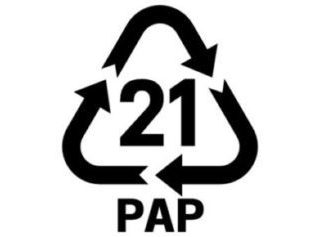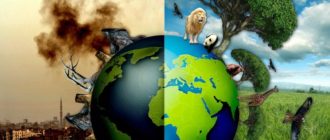All products on store shelves are in packaging that is properly labeled with recycle symbols.
This is done so that a person can dispose of it properly and not just throw it in the trash for further recycling and reuse.
Why do we need the recycle symbols?
The recycling symbols on the packaging of products contain information about the type of material from which they are made. With special symbols, the manufacturer tells the consumer what to do with the packaging after the product has run out.
We can highlight 5 most important recycling symbols:

Schematic of a person (“tiny man”) throwing trash in the waste bin. This sign shows that the packaging is relatively environmentally friendly and can be thrown away. The sign may contain captions urging people not to litter.

Three arrows closed in a loop. This is a “Mobius loop”. It indicates that the packaging is recyclable. There is usually a lot of useful information around the loop. If there is nothing around the loop, it means the product is partly or completely made from recycled materials. Three arrows mean: Recycle – Reuse – Reduce.

2 arrows closed in a circle. The sign can be green or black, and it strongly resembles the “Yin-Yang.” This is the Green Dot, which is accepted in European countries and means that the manufacturer accepts packaging from their goods for recycling.
A crossed-out recycling bin means that the contents of the packaging are toxic and should not be discarded with household garbage. Usually such a sign is on packages with hazardous waste that cannot be simply thrown into the trash, such as (by clicking on the links you can read how to dispose of this or that type of waste): energy-saving mercury lamps and thermometers, batteries and rechargeable batteries, household appliances (microwave ovens, washing machines, refrigerators, TV sets) and electronics, including office equipment (computers, monitors, printer cartridges, phones).

A loop with a plant growing out of it – a sign for compostable materials – the items with this sign can be placed into the garden waste bin.
Sometimes it’s enough just to look at the packaging and find the recycling (disposal) sign to know what to do with it.
Types of labeling depending on the type of packaging
Let’s return to the Mobius loop, the recycling symbol. In and around this triangle, there are symbols and codes that tell us what kind of material the packaging is made of and where to dispose of it.
Usually there is a number inside the loop and several letters below it.

- 01 PET is labeled on beverage and oil bottles, disposable food containers, and bottles for liquid soap or other detergents. We recommend reading an interesting article on recycling PET bottles.
- 02 HDPE or PE-HD is a denser plastic (high-pressure polyethylene) and is therefore used to make bottles for cleansers and detergents, canisters and closures. This type of plastic is also recyclable. We also recommend to read an informative article about recycling high-pressure polyethylene.
- 03 PVC is the raw material for window frames, plastic pipes, pill blisters, cake containers, and shrink wrap.
- 04 LDPE is a soft plastic that is used for making bags.
- 05 PP is used for making disposable and reusable tableware, toys, bottle caps and much more. Polypropylene can be heated but you should not pour alcohol into it. It is possible to recycle PP waste.
- 06 PS is polystyrene which is used for making food film, egg cartons, flower pots, CD packaging. Polystyrene can also be foamed. It is used to package instant noodles, meat, and sometimes pastries.
- 07 Other or O indicates blended plastic, which is not a viable source of recyclables. Blended plastic is used to make soft packaging for coffee and pet food.

Pay attention to the oxo-biodegradable plastic (d2w) label.
The manufacturer adds an additive that accelerates the breakdown of plastic in the environment. The plastic made with s2w technology is meant to fall into pieces and bioassimilate at the end of its useful like – generally 18 months.
However, this additive does not help to fight plastic pollution, it only provokes the appearance of microplastics.
Paper and cardboard
Recycled paper symbols are coded as follows:
- 20 PAP sign indicates corrugated cardboard;
- 21 PAP indicates other types of paperboard, e.g. binding or heavy cardboard for cards;
- 22 PAP stands for all other types of paper.

All paper that is free of impurities must be recycled. Before sending paper or cardboard for recycling, it is worth checking if there is no thin layer of film on it. Manufacturers often apply a film in order to maintain the original shape of the box.
It is easy to find out if there is a layer of film – you just have to tear the edge of the box slightly. The film can be then seen immediately and it prevents the carton from being torn.
Metals and Glass
- 40 FE indicates tin. It is used to make cans and aerosol cans and can be taken to any scrap yard.
- 41 ALU is used for beverage cans, foil and cream tubes. Waste aluminium can also be taken to a scrap yard.
- 70-74 GL stands for glass, and you’d find separate recycle containers for glass waste. Some types of glass products require special skills, e.g. the disposal of mirrors must be handled in a special way.

All metals and glass can be recycled countless times and do not lose their properties. Therefore, all metal products, even those that are not labelled as recyclable, are recyclable.
Organic Materials
Organics, although environmentally friendly, is also labelled with recycling symbols:
- 50 FOR indicates a product made of wood;
- 51 FOR marks cork products;
- 60 TEX indicates cotton products;
- 61 TEX indicates jute fibre, which is used to make sacks, twine and rope.
Organic waste decomposes naturally and is safe for nature and humans. It can be used as fuel, but it is best to recycle it as it will produce something new.
Composite materials
80-100 C/PAP stands for blended material, indicated by the letter C. After the slash there is the base material from which the packaging is made (here PAP).
A prime example of composite material is Tetrapak, which is a mixture of cardboard, plastic and foil. Composite materials are often used for crafts activities with children at school or kindergarten.
Ecological safety labels
The specific marking of goods makes it clear under which conditions the goods have been produced and how safe they are for the environment.
To indicate environmentally friendly production conditions, each country uses its own symbol.

“Blue Angel” is adopted for use in Germany. The badge depicts a blue silhouette of a person in a white circle with leaves around the edges. Der blaue Engel” is written at the top of the sign. It is used to mark four products: household items and textiles, paper and cardboard, electrical appliances and building equipment. Even services can be labelled with the symbol if they are carried out in an environmentally friendly way.
“The White Swan is used in northern Europe. Inside the circle, diagonal green stripes can be seen with the bird’s silhouette. Around the circle, the inscription “Nordic Environmental Label” can be seen. The product that bears this label has been subjected to strict testing by the Nordic countries and is free of harmful impurities and recyclable.
The Swedish Society for Nature Conservation seal indicates that the product has been manufactured free of hazardous substances. The sign is black and white and a bird can be seen inside it. The words “Bra miljöval”, which stand out from the rest, literally mean “good environmental choice”. It is not only used for labelling goods, but also for some services, such as public transport. The assessment criteria are tough but fair.
The EU Flower is a voluntary eco-label that identifies a product as being “green”. It resembles a flower with stars as its petals and the letter E as its centre. It is applied in all EU countries. It can be found on cleaning products and detergents, textiles and household appliances.

EcoLogo is adopted worldwide but is particularly common in the US and Canada. It is designed as a green rectangle with rounded edges. Inside it is a circle with a green leaf and the letters UL. It is used to indicate construction materials, toiletries, cleaning products, electronics, and office supplies.
Green Seal is a label that is also used in the USA. It consists of a blue circle with a green tick through it. The Green Seal is visible along the edge of the circle. The marking is found on household chemicals, building materials and paper products. Even restaurants and hotels that have been certified are marked with it. The “Leaf of Life” certificate is the only label in Russia that was adopted and recognized by the World Ecolabelling Association. This certification applies to food, household chemicals and other products and is completely voluntary in Russia. The Ecological Union in St. Petersburg analyses the entire life cycle of a product, from production to transport to the counter. The commission’s experts are thorough, and not every company passes the test the first time. The “leaf of life” also comes in handy in agriculture. Responsible farmers use it to prove that their farm is environmentally friendly.
The “Leaf of Life” certificate is the only label in Russia that was adopted and recognized by the World Ecolabelling Association. This certification applies to food, household chemicals and other products and is completely voluntary in Russia. The Ecological Union in St. Petersburg analyses the entire life cycle of a product, from production to transport to the counter. The commission’s experts are thorough, and not every company passes the test the first time. The “leaf of life” also comes in handy in agriculture. Responsible farmers use it to prove that their farm is environmentally friendly.
The eco-certificate of Ukraine depicts a silhouette of a crane. The “green crane” demonstrates the use of clean production technology combined with the quality environmental and performance benefits of a specific product. If you see products marked with this symbol, you know that they have been ecologically certified according to the requirements of international standard ISO 14024 (DSTU ISO 14024) and have improved environmental performance compared to other products on our market.It should be noted that the environmental certification of products is not a mandatory procedure. The objects of certification include: food products, a variety of goods and products, services, real estate, etc.But there are goods for which no ecological certificate can be issued. These include medicines and tobacco products.
All recycling and disposal signs (including all eco-labels) have been adopted with the participation of international environmental organizations.
It is important to recognize the ecolabels and recycling symbols and apply this knowledge in practice. By understanding the symbols, people can sort recyclable materials more carefully and buy more environmentally friendly products and products. It is also useful to distinguish genuine certification marks, as this can prevent counterfeiting.






